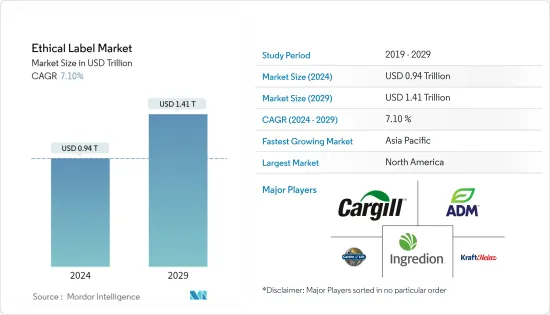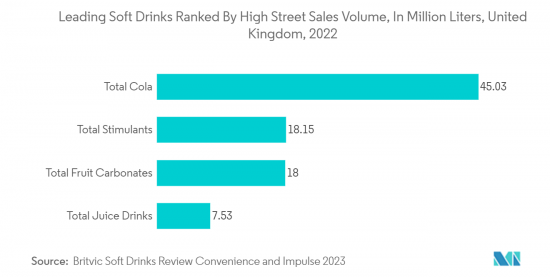 |
市場調查報告書
商品編碼
1406167
Ethical Label:市場佔有率分析、產業趨勢/統計、成長預測,2024-2029Ethical Label - Market Share Analysis, Industry Trends & Statistics, Growth Forecasts 2024 - 2029 |
||||||
※ 本網頁內容可能與最新版本有所差異。詳細情況請與我們聯繫。
Ethical Label市場規模預計到 2024 年將達到 9,400 億美元,預計到 2029 年將達到 1.41 兆美元,預測期內(2024-2029 年)複合年成長率為 7.10%。

對正確食品消費的高度認知和關注正在推動食品和飲料公司提高透明度並為其產品採用Ethical Label。
主要亮點
- 消費者對永續實踐、公平貿易和道德採購的興趣日益濃厚,正在推動Ethical Label市場的發展。隨著消費者越來越想知道個別食品如何影響環境,這個市場正在不斷成長。Ethical Label市場是由某些食品和食品和飲料的接受程度以及消費者消費習慣的變化所推動的。猶太和穆斯林消費者的貢獻歸功於猶太潔食和清真道德認證產品的興起。
- 在生產和消費中倡導高道德標準越來越影響公司選擇Ethical Label,以促進遵守環境永續性、動物福利、社會正義、平等、更有前途的職場和工人素質,從而提振市場。
- 許多人群,尤其是千禧世代,在提高對健康、清潔和認證產品的意識方面具有很大影響力。這種趨勢也蔓延到嬰兒潮世代。消費者正逐漸轉向更有營養的飲食習慣。根據《世界有機貿易指南》,2022 年日本健康與保健 (HW) 包裝食品和飲料的零售達到約 563 億美元。該行業正在穩步成長,預計到 2025 年將超過 573 億美元。
- 然而,Ethical Label通常需要額外的認證和合規措施,這可能會導致製造商和供應商的成本增加。這些額外成本可以轉嫁給消費者,使得道德產品比不道德的替代品相對更昂貴。
- 研究市場的另一個抑制因素是某些地區和市場上帶有Ethical Label的產品的供應有限。這可能是由於多種因素造成的,包括產能有限、分銷課題以及某些地區需求不足。標準化Ethical Label法規和指南還可以提高市場的透明度和一致性。
Ethical Label市場趨勢
飲料佔最高市場佔有率
- 由於人們對酒精、碳酸和砂糖飲料消費的擔憂日益加劇,預計飲料業將佔據強勁的市場佔有率。
- 此外,飲料行業在維持道德對待動物和確保安全方面的聲譽方面面臨課題。包裝椰子水和非乳類飲料等植物性飲料的出現也是純素食者標籤市場的主要動力。
- 據 Kiln & Company 稱,健康生活已發展到包括全面的自我護理方法。它鼓勵吃健康的有機食品、服用補充品、使用清潔產品、運動和控制壓力。為了尋求更環保、更衛生的生活方式,消費者選擇被視為「清潔」或「天然」的飲料。聲稱無無麩質、非基因改造、不含人工色素和防腐劑、有機和草飼的產品正在零售貨架上佔據越來越多的空間。
- 從地區來看,亞太地區預計將提供巨大的成長機會,因為該地區的經濟成長顯著增加了消費者的可支配收入並改變了生活方式。預計這些因素將影響該地區包裝飲料的需求。根據中國國家統計局數據,2022年11月,中國非酒精飲料產量約1,097萬噸。
- 茶、咖啡、可可基飲料和包裝水等傳統飲料的普及很高。此外,獲得清真認證和道德認證的產品用於包裝飲用水,也得到了消費者的支持。此外,碳酸飲料等傳統飲料中低熱量產品的採用也影響了潔淨標示的需求。
- 由於軟性飲料的受歡迎程度和全球消費量的增加,軟性飲料在調查市場中佔據了很大佔有率。根據 UNESDA 統計,砂糖、低熱量飲料目前佔許多歐洲市場銷售額的 30%。根據 Britvic Soft Drinks Review Convenience and Impulse 的數據,2022 年英國可樂總銷量為 4,503 萬公升。
- 此外,飲料行業的製造商正在選擇足夠利基的Ethical Label,以將其與競爭品牌區分開來並吸引廣泛的客戶。這進一步推動了飲料行業Ethical Label市場的成長。

亞太地區預計將出現強勁的市場成長率
- 不斷變化的消費者需求和對一致食品品質的需求正在推動亞太地區對Ethical Label解決方案的需求,以保持高品質和生產力。
- 亞太地區飲料生產和消費的增加可能為研究市場的成長提供利潤豐厚的機會。例如,根據中國國家統計局的數據,2023年1月至2月,中國軟性飲料產量約2,690萬噸,年增0.5%。此外,2022年11月,中國飲料產量約1,100萬噸。此外,2022年8月,中國軟性飲料產量約1,885萬噸。
- 此外,根據中國國家統計局的數據,2022年中國牛奶產量約3,930萬噸,創近年來最高水準。
- 由於繁忙的工作安排、職業女性數量的增加以及向移動消費的轉變,該地區對包裝食品的大力支持,預計將利用整個食品行業創新和永續的Ethical Label市場。增加。這可能會在預測期內推動市場成長。
- 根據加拿大農業和農業食品部統計,近期中國包裝食品零售約2,980.1億美元。此外,預計2025年包裝食品零售額將達3,667億美元。
- 此外,清真、有機和清潔認證等特定區隔市場的大量供應商的出現減少了低階和高階產品之間的價格差異,從而軟化了轉換成本。預計有幾家公司將在預測期內擴大其全球業務,特別是在亞太地區。
Ethical Label產業概述
Ethical Label市場由Archer-Daniels-Midland Company、Cargill Inc. 和 Garden of Life (Nestle SA) 等幾家大公司整合並主導。供應商基於產品品質、乾淨和免費的標籤以及有競爭力的價格進行競爭。透過設計、技術和應用的創新可以獲得永續的競爭優勢。市場的主要發展包括:
2023 年 3 月,ingredion 在其功能性潔淨標示成分解決方案系列中推出了兩種柑橘纖維調質劑Fibertex CF 502 和 Fibertex CF 102。此舉是為了滿足消費者對含有他們認可和熟悉的成分、具有健康益處、食品和新鮮聲稱的食品日益成長的偏好。這款新型柑橘質調質劑是該公司為滿足潔淨標示食品日益成長的需求以及日益流行的營養、健康和保健趨勢而做出的努力的一部分。
2022 年 3 月,帝斯曼開發了 DelvoGuard 菌種,以滿足想要使用潔淨標示成分的生產商的需求。該解決方案還有助於延長優格、起司和優酪乳乳製品的保存期限。
其他福利
- Excel 格式的市場預測 (ME) 表
- 3 個月的分析師支持
目錄
第1章簡介
- 研究假設和市場定義
- 調查範圍
第2章調查方法
第3章執行摘要
第4章市場洞察
- 市場概況
- 產業吸引力-波特五力分析
- 供應商的議價能力
- 消費者議價能力
- 新進入者的威脅
- 替代品的威脅
- 競爭公司之間的敵對關係
- 產業價值鏈分析
- 評估 COVID-19 對產業的影響
第5章市場動態
- 市場促進因素
- 消費者健康和道德意識不斷增強
- 透過線上零售和企業社會責任活動實現成長
- 減少肉類消費以保護環境
- 市場抑制因素
- 競爭加劇
第6章市場區隔
- 依標籤類型
- 清真
- 有機的
- 乾淨的
- 永續性和公平貿易標籤
- 動物福利標籤
- 純素食者標籤
- 其他
- 依產品類型
- 食品
- 飲料
- 依分銷管道
- 離線
- 線上的
- 依地區
- 北美洲
- 歐洲
- 亞太地區
- 其他地區
第7章 競爭形勢
- 公司簡介
- Archer-Daniels-Midland Company
- The Hershey Company
- Cargill Inc
- Go Macro LLC
- Garden of Life(Nestle SA)
- Kerry Group PLC
- Koninklijke DSM NV
- PepsiCo Inc.
- The Kraft Heinz Company
- Ingredion Incorporated
第8章投資分析
第9章 市場機會及未來趨勢

The Ethical Label Market size is estimated at USD 0.94 trillion in 2024, and is expected to reach USD 1.41 trillion by 2029, growing at a CAGR of 7.10% during the forecast period (2024-2029).
A high degree of awareness and concern regarding the right food consumption drives food and beverage companies toward transparency and adopting ethical labels for their products.
Key Highlights
- The increased consumer interest in sustainable practices, fair trade, and ethical sourcing drives the ethical labels market. The market is expanding because consumers are increasingly interested in learning how individual food products affect the environment. The ethical labels market is driven by the acceptance of certain foods & beverages and the shift in consumers' consumption habits. The contribution of Jewish and Muslim consumers can be attributed to the rise of kosher and halal ethical-certified products.
- The advocacy of high ethical standards for manufacturing and consumption increasingly influences companies to opt for ethical labels, which promote environmental sustainability, animal well-being, social justice, equality, and adherence to a more promising workplace and worker qualities, thereby boosting the market.
- A sizeable population, especially millennials, has been influential in increasing awareness toward healthy and clean-certified products. This trend is increasing in the baby boomer population as well. There is a gradual shift among consumers toward more nutritious eating habits. According to the Global Organic Trade Guide, in 2022, the retail sales value of health and wellness (HW) packaged food and beverages in Japan amounted to around USD 56.3 billion. The sector was forecast to grow steadily and exceed USD 57.3 billion in 2025.
- However, ethical labels often require additional certifications and compliance measures, which can lead to increased costs for manufacturers and suppliers. These additional costs may be passed on to the consumers, making ethical products relatively more expensive compared to non-ethical alternatives.
- Another restraint for the studied market is the limited availability of products with ethical labels in some regions or markets. This can be due to various factors like limited production capacity, distribution challenges, or lack of demand in certain areas. Also, standardized regulations or guidelines for ethical labeling can create clarity and consistency in the market.
Ethical Label Market Trends
Beverages To Occupy Highest Market Share
- The beverage industry is anticipated to occupy a robust market share as there is a growing concern over consuming alcoholic, carbonated, and sugar-based beverages; now, the focus has shifted toward non-alcoholic, plant-based alternative beverages among health-conscious consumers worldwide.
- Further, the beverage industry faces challenges in maintaining the reputation of ethical treatment of animals and ensuring safety. The emergence of plant-based beverages, like packaged coconut water and non-dairy milk beverages, is another primary driver for the vegan label market.
- According to Kilne & Company, healthy living has evolved to include a holistic approach to self-care. This encourages eating a healthy organic diet, taking supplements, using cleaner products, exercising, and managing stress. In their quest to live greener and more hygienic, consumers choose beverages they perceive as 'clean' or 'natural.' Products claiming to be gluten-free, non-GMO, free of artificial colors and preservatives, organic, and grass-fed are gaining more and more space on retail shelves.
- In terms of geography, the Asia-Pacific region is expected to offer significant growth opportunities as the economic growth of the region has significantly enhanced the disposable income of the consumers, along with a changing lifestyle. These factors are expected to influence the demand for packaged beverages in this region. According to the National Bureau of Statistics of China, in November 2022, about 10.97 million metric tons of non-alcoholic beverages were produced in China.
- Conventional beverages such as tea, coffee, cocoa-based, and packaged water are witnessing high adoption. Additionally, halal, ethical-certified products have found their way into packaged water, gaining consumer traction. Further, adopting low-calorie variants in conventional beverages, such as carbonated soft drinks, also influences the demand for clean labels.
- Soft drinks hold a substantial share of the market studied, owing to the popularity of such beverages and increasing consumption worldwide. Soft drinks offer various flavors and formats to suit every drinking occasion; according to UNESDA, sugar-free, low-calorie beverages currently account for up to 30 percent of sales in many European markets. According to Britvic Soft Drinks Review Convenience and Impulse, the total cola sales volume was 45.03 million liters in 2022 in the United Kingdom.
- Moreover, manufacturers in the beverage industry are choosing ethical label which is niche enough to differentiate them from other competitor brands and want to appeal to a broad base of customers. This is further fueling the growth of the ethical label market in the beverage industry.

The Asia Pacific Region is Anticipated to Register Robust Market Growth Rate
- The changing consumer demand and the need for consistent food quality have created the need for ethical labeling solutions to maintain high quality and productivity in the Asia Pacific region.
- The increasing beverage production and consumption in the Asia Pacific region is likely to offer lucrative opportunities for the growth of the studied market. For instance, according to the National Bureau of Statistics of China, in January and February 2023, around 26.9 million metric tons of soft drinks were produced in China, showing a 0.5 percent increase compared to the same period of the previous year. In addition, in November 2022, approximately 11 million metric tons of beverages were produced in China. Furthermore, in August 2022, approximately 18.85 million metric tons of soft drinks were produced in China.
- Further, according to the National Bureau of Statistics of China, in 2022, China had an output of approximately 39.3 million metric tons of cow's milk, the highest volume in recent years.
- In the region, packaged foods are gaining high traction owing to busy work schedules, the rising number of working women, and the shift toward on-the-go consumption, which is anticipated to increase the utilization of innovative and sustainable ethical label markets across the food sector. This is likely to fuel the market's growth during the forecast period.
- According to Agriculture and Agri-Food Canada, packaged food retail sales in China were about USD 298.01 billion recently. Further, the packaged food retail sales are expected to reach USD 366.7 billion in 2025.
- Additionally, the switching cost is becoming moderate due to the decreasing price differentiation of low-end and high-end products due to the emergence of numerous vendors in certain segments like halal, organic, and clean certifications. Several players are anticipated to expand their presence worldwide during the forecast period, especially in the APAC region.
Ethical Label Industry Overview
The ethical label market is consolidated and dominated by a few major players like Archer-Daniels-Midland Company, Cargill Inc., Garden of Life (Nestle S.A.), etc. The vendors compete based on product quality, clean, free tags, and competitive pricing. Sustainable competitive advantage can be gained through design, technology, and application innovation. Some of the key developments in the market are:
In March 2023, ingredion introduced two citrus fiber texturizers, Fibertex CF 502 and Fibertex CF 102, to its range of functional, clean-label ingredient solutions. This move is in response to the increasing consumer preference for food products containing ingredients they recognize and are familiar with and those that are beneficial to health and have natural, fresh claims. The new citrus-based texturizers are part of the company's effort to meet the accelerated demand for clean-label food and the rising popularity of nutrition, health, and wellness trends.
In March 2022, DSM developed DelvoGuard cultures to meet the needs of producers who want to use clean-label ingredients. This solution also helps to extend the storage life of dairy products like yogurt, cheese, and sour cream.
Additional Benefits:
- The market estimate (ME) sheet in Excel format
- 3 months of analyst support
TABLE OF CONTENTS
1 INTRODUCTION
- 1.1 Study Assumptions and Market Definition
- 1.2 Scope of the Study
2 RESEARCH METHODOLOGY
3 EXECUTIVE SUMMARY
4 MARKET INSIGHTS
- 4.1 Market Overview
- 4.2 Industry Attractiveness - Porter's Five Forces Analysis
- 4.2.1 Bargaining Power of Suppliers
- 4.2.2 Bargaining Power of Consumers
- 4.2.3 Threat of New Entrants
- 4.2.4 Threat of Substitutes
- 4.2.5 Intensity of Competitive Rivalry
- 4.3 Industry Value Chain Analysis
- 4.4 Assessment of the Impact of COVID-19 on the Industry
5 MARKET DYNAMICS
- 5.1 Market Drivers
- 5.1.1 Increased Consumer Conscious toward Health and Ethical Values
- 5.1.2 Growth due to Online Retailing and CSR Activities
- 5.1.3 Reduction in Meat Consumption for Environmental Sustainability
- 5.2 Market Restraints
- 5.2.1 Increasing Competition Among Players
6 MARKET SEGMENTATION
- 6.1 By Label Type
- 6.1.1 Halal
- 6.1.2 Organic
- 6.1.3 Clean
- 6.1.4 Sustainability and Fairtrade labels
- 6.1.5 Animal Welfare Labels
- 6.1.6 Vegan Labels
- 6.1.7 Other Label Types
- 6.2 By Product Type
- 6.2.1 Food
- 6.2.2 Beverages
- 6.3 By Distribution Channel
- 6.3.1 Offline
- 6.3.2 Online
- 6.4 By Geography
- 6.4.1 North America
- 6.4.2 Europe
- 6.4.3 Asia-Pacific
- 6.4.4 Rest of the World
7 COMPETITIVE LANDSCAPE
- 7.1 Company Profiles
- 7.1.1 Archer-Daniels-Midland Company
- 7.1.2 The Hershey Company
- 7.1.3 Cargill Inc
- 7.1.4 Go Macro LLC
- 7.1.5 Garden of Life (Nestle S.A.)
- 7.1.6 Kerry Group PLC
- 7.1.7 Koninklijke DSM N.V
- 7.1.8 PepsiCo Inc.
- 7.1.9 The Kraft Heinz Company
- 7.1.10 Ingredion Incorporated





